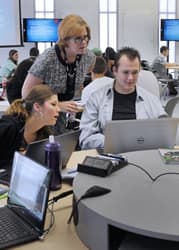New active learning classrooms fostering real-world student collaboration

On the second floor of the Kennedy Building, two new classrooms are challenging faculty to better design and deliver courses that promote greater collaboration among students.
The rooms are brightly painted and well-lit, and they are outfitted with a number of technological innovations. The hallway walls are made up of clear and frosted glass, which can be written on like whiteboards. Both rooms accommodate student teams; the larger space, Room 236, is designed for classes of 126 students. Room 234 has seating for 36. The collaborative nature extends to the hall outside the classrooms with comfortable seating and three monitors that students can hook their laptops to work together.
“The entire design of the rooms is geared toward active, hands-on learning and team-based learning and problem solving,” said Garvey Pyke, director of the Center for Teaching and Learning. The center collaborated on the rooms’ creation with the Office of Classroom Support and the Office of Academic Affairs. “One of the unique aspects of the design is the different configurations possible, which provides great flexibility for faculty members who teach in them.”
In Room 236, there are 14 tables that seat nine students, but faculty can form smaller teams. The tables have three laptops and a large plasma screen display for students to share their work. Faculty members have a smart podium with five drop-down screens, but they can use a wireless microphone system and iPad control to walk throughout the classroom.
 And anthropology professor Coral Wayland is one who does. In a recent class on the history of epidemics, Wayland interacted with the student teams who used the laptops at their stations to access the Internet to research aspects of Cholera.
And anthropology professor Coral Wayland is one who does. In a recent class on the history of epidemics, Wayland interacted with the student teams who used the laptops at their stations to access the Internet to research aspects of Cholera.
“I’ve taught this course before, which is intended to impart 21st-century skills, but it was in a 20th-century classroom. I love that I can now organize student teams and have them engage in an application exercise,” said Wayland.
Architecture professor Nick Senske is teaching the required foundational course “Computational Methods.” He said the active learning classroom enables him to teach the way he wants to and the way his students want to learn.
“In stadium seating, the classes were very formal. I talked for about 60 to 75 minutes with occasional pauses to involve students by asking questions. Now, I break up my primary lecture topics into 20 to 25 minute units and incorporate technology to keep the room at a high level of engagement,” said Senske. He, too, utilizes group activities with discussions that tie back into the lecture.
Both Wayland and Senske view the room’s design as superior to the traditional fixed-row lecture hall.
“The classroom is focused on them (students), not me,” said Senske. “It emphasizes the role of the students in taking charge of their own learning. Instead of a dark room filled with chairs, the room is bright and full of generously spaced tables, so the students face each other rather than the instructor.”
Plus, there’s no place to hide, Wayland added. “There’s no front or back to the classroom, and with the microphones at each group of tables, the students can hear me and each other. All voices are heard unlike a fixed-row lecture hall where students often have to repeat something for the rest of the class to hear.”
Heather McCullough, associate director for the Center for Teaching and Learning, said the new classrooms are an experimental space that will enable the center to explore how the classes are managed collaboratively.
“We’ve developed an academy model for faculty members teaching in these classes to provide them with support and guidance on how to be successful and use the rooms to their full potential,” McCullough stated. “We’ll come together to discuss their experiences and how they and students utilized the space. One of our goals is to foster a community of practice around active teaching and active learning.”
While the technology within the active learning classrooms can be daunting, CTL officials and faculty noted the key is to not be overwhelmed. Plus, faculty members who use the rooms receive classroom support from student technicians virtually around the clock, said McCullough.
Wayland advised future faculty who use the spaces to focus on hands-on learning and the use of Web-based activities that engage students. For Senske, he said prospective faculty should examine how best to deliver content in a carefully crafted manner.
“Faculty members don’t have to get rid of their lectures, but they do have to work on making them more concise, breaking them down into shorter, more powerful talks. The students can fill in the rest with group activities and other content, but the professor has to ignite their passion and establish big ideas,” Senske explained.
The bottom line for faculty members is if they’re the only one working in the active learning classrooms, then they’re doing something wrong, said CTL’s Pyke.
Photos by Wade Bruton